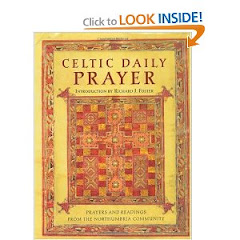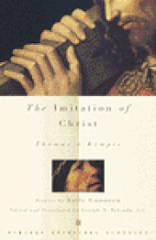Why Celtic?
Here I stand; and I say a prayer.
Things Celtic are currently very much in fashion - but that was not so much the case when these liturgies were first devised. In order to make sense of the journey, we needed to 'explore the old paths' to find what they could teach us. Often these are neglected in the headlong embrace of everything that is new. The 'old paths' all around us here in Northumbria resound with the start-ling tes¬timony of the remarkable men and women who simply loved God and followed Jesus wherever the Spirit impelled and empowered them to go; they lit a fire in the so-called 'dark ages' that brought warmth, culture, learning and, most of all, faith to vast numbers of people.
As we researched and studied these saints (and the Desert Fathers, who were their spiritual predecessors) we found that many of the lessons they taught gave us hope and coherence on our own journey: that.people matter more than things, and rela¬tionships more than reputation; that prater and action, contempla¬tion and involvement, all belong together. Whilst resisting the temptation to hark back to some mythical 'golden age' (which probably never existed), we have attempted to be true to what we have learned and lived in the shadow of the Northumbrian saints and their teachers. We are not trying to say that these prayers and simple liturgies are similar to anything used in seventh-century Northumbria; but we do hope that the relevance and immediacy of their style reflect the faithful and uncompromising lives of those whose example we attempt to follow. Most of this book is best used on an individual basis or in the context of a small family group.
Some of the prayers, stories and illustrations in this book are very old; others are quite modern. We make no apologies for this mix. If the early Celtic saints (and those whom they taught to follow in similar well-trodden ways of prayer and courageous mis¬sion) have much to say to us in our own generation and culture, then it must be interpreted in a modern idiom where necessary.
The Northumbria Community
God called forth a people; and we responded to His call.
The Northumbria Community in its present form emerged as an expression of the mixed life that embraces both the contemplative and the apostolic in the context of a shared vision and vocation. Historically, Celtic Christian monasticism was noted for its com¬bining of monastery and mission. Ordinary Christian people found ways of weaving disciplines of prayer into their daily life. From the earliest days we were aware of this call to a continuity of purpose which would enable us to help 'rebuild the ancient ruins and raise up the age-old foundations' of our fore-fathers and -mothers in the faith. We were being slowly drawn into a monastic way, but this was a new and different monasticism. Dietrich Bonhoeffer spoke of a similar call when he wrote: 'The renewal of the Church will come from a new type of monasticism which only has in common with the old an uncompromising allegiance to the Sermon on the Mount. It is high time people banded together to do this.'
This understanding of people united by a common vision was central to our formation as a geographically dispersed Community. In effect two groups came together: the one mainly emphasizing the monastic, contemplative stream; and the other emphasizing the apostolic and the need to take the monastery through mission into the marketplace. The former were represented by the original 'Nether Springs Trust' which was formed to release John and Linda Skinner into establishing this 'new monastic' vision. The latter were Northumbria Ministries, led by Roy Searle, whose vision was to see fires lit all over the ancient kingdom of Northumbria - and to carry the torch of the gospel wherever the Father leads. The merging of the two groups in 1990 formed the Northumbria Community. In our growth and development we have gradually understood that for us this being 'banded together' was expressed in being alone yet together, enriched by our diversity but united in heart by our common commitment to our vows, in which we say 'YES' to Availability and Vulnerability, and in being com¬panions together in Community.
Since the Community is widely dispersed, Community groups have been established, meeting monthly, wherever companions in a local area wish to form one. Inevitably these groups take on a life and form of their own, and each individual contributes to the wide variety of experience and styles of a disparate group of people finding themselves on a journey together.
Friendship and the sharing of stories, music and the arts in general provide the natural means to help us engage with people of all backgrounds and interests in a manner that leaps across the boundaries of church and religion. In recent months we have paid special attention to encouraging those with an interest in story-telling, and to teaching the skills that make it such an effective bridge-building tool.
Our trading company, Cloisters, has a mail order business sell¬ing calligraphic cards, stained-glass ornaments, honey from the Community's beehives and so on, and is developing music and book publishing activities to enable the stories and insights to be passed on to a wider audience. This reflects the desert tradition of 'basket-making' and helps raise funds for the Community.
In carrying out these activities, we are very concerned that the Community does not become institutionalized. The rather anony¬mous, raw and ragged style of the early part of the journey remains a vital part of the Community's ethos as it grows and develops. We aspire to measure ourselves constantly against these words of William Stringfellow, which have long been an inspiration to us:
Dynamic and erratic, spontaneous and radical, audacious and immature, committed if not altogether coherent. Ecumenically open and often experimental; visible here and there, now and then but unsettled institutionally. Almost monastic in nature, but most of all enacting a fearful hope for society.
The Community is rather like a big, sprawling family; gather¬ings are often family reunions! All means are sought to strengthen the bonds between us (and to provide channels of healing where there is dispute).
As these and the other liturgies in this collection were devised, accepted and recorded, they came to be published initially in filo-fax form, with each month's series of Daily Readings being dis¬tributed to subscribers to add into the binder. Somewhat to everybody's surprise, this began to circulate more widely, and the demand led to the publication by HarperCollins first of Celtic Daily Prayer and, subsequently, Celtic Night Prayer. This current book combines the best of both these volumes for the first time, together with other material not included in them. It is our prayer that, whether or not you wish to join us as companions on our journey, you will find material here that will enrich your spiritual life and draw you closer to God.
From the beginning, all the daily prayers (except the Complines) have had sung, as well as spoken, versions; and many of the meditations, and parts of other liturgies, also have musical settings. The sung versions of Celtic Daily Prayer have been made available in high-quality recordings on CD and audiotape. These have played an important part in linking companions together wherever they may be - at home, in an office or in the car driving to work.
The Community Rule of Availability and Vulnerability
I say 'Yes, my Lord' in all the good times, through all the bad times.
In the same way as the liturgies emerged from lives actually lived in community, so has the Community's Rule. It is a response to that insistent question: 'How then shall we live?' It is a call to risky living: it is not a comfortable or easy solution to life's prob¬lems. Whilst we welcome any who wish to walk with us in seeking God, we ask that those who wish to become Companions with us in Community say 'YES' to Availability and Vulnerability as their way of living. This involves availability to God and to others - expressed in a commitment to being alone with God in the cell of our own heart and to being available for hospitality, intercession and mission. Intentional vulnerability is expressed through being teachable in the discipline of prayer, saturation in the Scriptures and being accountable to one another, often through soul friendships. It also means 'embracing the heretical imperative' (challenging assumed truth), being receptive to con¬structive criticism, affirming that relationships matter more than reputation, and living openly among people as 'church without walls'. This is not something to be entered into lightly!
Get the book and start living a daily life in Christ . . . seek the ancient paths that lead you on the Narrow Road.
Subscribe to:
Post Comments (Atom)










No comments:
Post a Comment